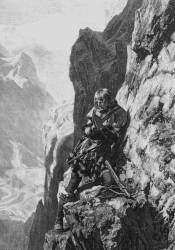Kaiser-Max-Grotte
Maximiliansgrotte - Martinswandgrotte
Useful Information

| Location: |
Zirl.
(47.2693906, 11.2692804) |
| Open: |
no restrictions. [2025] |
| Fee: |
free. [2025] |
| Classification: |
 Karst Cave Karst Cave
|
| Light: | bring torch |
| Dimension: | Trail: L=1.8 km, VR=200 m, D=1 h. |
| Guided tours: | self guided |
| Photography: | allowed |
| Accessibility: | no |
| Bibliography: | |
| Address: | Kaiser-Max-Grotte |
| As far as we know this information was accurate when it was published (see years in brackets), but may have changed since then. Please check rates and details directly with the companies in question if you need more recent info. |
|
History
| 1484 | Kaiser Maximilian I trapped in the cave. |
| 1936 | wooden statue of Kaiser Maximilian I created by the sculptor Johannes Obleitner. |
| 2015 | Grottensteig trail renovated. |
Description
It’s not easy to visit the Kaiser-Max-Grotte (Emperor Maximilian Grotto), as it is located in the middle of a vertical cliff face named Martinswand, 200 m above the valley floor. Kaiser Maximilian I of Austria learned this when he was hunting and was not able to find his way down again. So he stayed in the cave for several days, enjoying the spectacular view on the Inn valley, the city Innsbruck, and the Stubai mountain ridge to the south, until he was finally rescued. Obviously the era before cell phones. And that’s the story how the cave got its name:
Emperor Maximilian I was a passionate hunter and was very fond of chamois hunting.
One day, when he came up here on a hunt, he lost his path and could no longer go forward or back.
He was trapped in the Martinswand and waited in the grotto for help.
He spent two days here.
According to legend the village at the foot of the Martinswand, takes its name from this event.
As the Emperor begged for help he said "wenns denn nur kematen" ("if only they would come").
This is how the village got its present name Kematen.
Emperor Maximilian was finally saved after two days by a peasant boy.
But when he was on safe ground the peasant boy just disappeared, and it was thought that a guardian angel had rescued the Emperor.
To commemorate his rescue, the Emperor had the large cross erected in the grotto.
From this day the cave was called the Emperor Maximilian Grotto.
Today the cave has a railing, two huge crosses and benches for the tired visitors. Its also unclear how much of the cvae is natural and how much was dug into the wall. According to one version of the story Maximilian I was trapped on a narrow ledge in the wall, and he ordered the creation of the cave to commemorate his rescue. It is rather popular, especially in the late afternoon. It is also frequented by climbers, because a rather difficult climbing route from the foot of the cliff ends here.
Today there is a confortable trail allowing access to the cave. Starting point is the Red Cross station at the city limits of Zirl. From here a gravel road leads to the huge limestone quarry of Plattner & Co Kalkwerk. The trail was built on the mountain slope above the quarry and after less than 2 km the Kaiser-Max-Grotte is reached. The trail was modernized only a few years ago, is rather wide and has railings and steel ropes along the wall for security. It does not require mountaineering skills, but surefootedness, no fear of heights and a short rope and carbine for safety are much recommended though.
 Search DuckDuckGo for "Kaiser-Max-Grotte"
Search DuckDuckGo for "Kaiser-Max-Grotte" Google Earth Placemark
Google Earth Placemark OpenStreetMap
OpenStreetMap Kaiser-Maximilians-Grotte
Kaiser-Maximilians-Grotte  - Wikipedia (visited: 17-MAY-2022)
- Wikipedia (visited: 17-MAY-2022) Kaiser-Max-Grotte
Kaiser-Max-Grotte  Index
Index Topics
Topics Hierarchical
Hierarchical Countries
Countries Maps
Maps